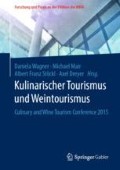Abstract
Both, the outstanding quality of nature conservation and the attractiveness of Southern Styria for daily visitors and tourists, are essentially based on the local landscape diversity, comprising viticulture, orchards, meadows, and forests. On top of this, the southernmost nature park of the province Styria, the Nature Park Southern Styria (est. 2002), contributes substantially to the scenic beauty in the Southern Styrian wine country. The concept “nature park” originated in the 1960s and initially intended to protect particularly attractive landscapes for visitors (Pröbstl 2004). The focus at the time already resembled the conservation of attractive cultural rather than natural landscapes. In addition, a nature park should foster environmental education, contribute to regional development and function as a role model for sustainable development in rural areas (Pröbstl and Schuster 2011). However, the outstanding landscape and biodiversity are endangered. Due to the increase of waste land, a gradual scrub and tree encroachment, and the intensification of viticulture, the amount of meadow and orchard lands is declining. If this trend continues without counteraction, the quality of tourism and biodiversity would be seriously threatened. In addition, difficulties may emerge regarding European commitments of the country in the field of European habitat and species conservation (Europäische Union 1992). The province of Styria commissioned a study in 2015 to investigate whether the problems can be solved through cooperation between tourism, nature conservation, and land users (particularly wine growers), creating a win-win situation for all participants. As current assumptions may be correct for some visitors and local businesses, it is highly unlikely that they will hold up for different visitor and business types. Therefore, the aim of the present study is to capture both, the perspectives of local businesses and tourists (daily visitors and vacationers), through an analysis of their willingness to contribute to the conservation of valuable cultural landscape in the Nature Park Southern Styria. In order to examine the potential for cooperation in favor of these diverse cultural landscapes, we interviewed experts of selected farms and surveyed Austrian and German tourists. The eleven expert interviews, led by Bernd et al. (2015), investigated the businesses’ relationship with the nature park and their perception of measures to promote landscape diversity. The online survey of 1663 Austrian and German daily visitors and vacationers observed their preferences and potential contributions to landscape conservation. The core of the survey built a choice experiment, a stated-preference method, which allows for the simultaneous analyses of multiple aspects of a hypothetical scenario and the subsequent determination of part worth utilities for each of those aspects (Louviere et al. 2000). The choice experiment in this study asked the 1072 vacationers to evaluate different holiday destinations in southern Styria based on their landscape characteristics, different (wine) adventure activities and infrastructure, and possible taxes and surcharges. Results show, that, despite the awareness that the outstanding natural beauty of the Southern Styrian wine country can only be preserved through a cooperation between land users, nature conservation, landscape management, and tourism, the nature park has not yet exercised its role as a regional mediator. Local businesses recognize the link between cultural landscape and nature conservation, yet, they do not feel informed or supported by the nature park. Therefore, future cooperation with local businesses seem likely and are even desired by some. The results of the choice experiment indicate that vacationers are not impacted by a surcharge as high as 0.50 EUR. The visitors are, as shown by supplementary questions, quite sensitive in terms of landscape change and the unlimited increase in the viticulture. An excessive dominance of viticulture in the natural landscape is judged negatively.
Literatur
Bernd G, Butz M, Kirsch A, Linhart LM (2015) Naturschutzfachliche und kulturelle Bedeutung von Weinbaulandschaften im Naturpark Südsteiermark. Endbericht im Zuge der gleichnamigen LV, Universität für Bodenkultur, Wien
Büro Freiland (2015) Präsentation vom 6. Mai 2015
Europäische Union (1992) Natura 2000. Richtlinie 92/43/EWG des Rates vom 21. Mai 1992 zur Erhaltung der natürlichen Lebensräume sowie der wildlebenden Tiere und Pflanzen
Louviere JJ, Hensher DA, Swait J (2000) Stated choice methods. Cambridge University Press, NY
Pröbstl U (2004) Nature parks as an instrument to protect mountainous regions: a comparison in central Europe. In: Ito T, Tanaka N (Hrsg) Social roles of forests for urban population – forest recreation, landscape, nature conservation, economic evaluation and urban forestry. Japan Society of Forest Planning Press, Tsukuba, 156–169. ISBN: 4-915870-30-8
Pröbstl U, Schuster S (2011) Naturpark Pöllauer Tal – eine Bilanz nach 20 Jahren Entwicklung im ländlichen Raum. In: ZOLL+, Nummer 18, S. 13–17
Author information
Authors and Affiliations
Corresponding author
Editor information
Editors and Affiliations
Rights and permissions
Copyright information
© 2017 Springer Fachmedien Wiesbaden GmbH
About this chapter
Cite this chapter
Pröbstl-Haider, U., Haider, W., Mostegl, N. (2017). Tourismus und Weinbau im Naturpark Südsteiermark in Österreich/Nature Park „Südsteiermark“, Austria: Tourism and Viniculture. In: Wagner, D., Mair, M., Stöckl, A.F., Dreyer, A. (eds) Kulinarischer Tourismus und Weintourismus. Forschung und Praxis an der FHWien der WKW. Springer Gabler, Wiesbaden. https://doi.org/10.1007/978-3-658-13732-8_12
Download citation
DOI: https://doi.org/10.1007/978-3-658-13732-8_12
Published:
Publisher Name: Springer Gabler, Wiesbaden
Print ISBN: 978-3-658-13731-1
Online ISBN: 978-3-658-13732-8
eBook Packages: Business and Economics (German Language)

